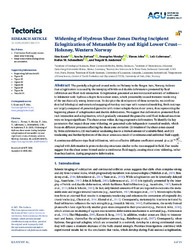Widening of Hydrous Shear Zones During Incipient Eclogitization of Metastable Dry and Rigid Lower Crust—Holsnøy, Western Norway
Labrousse, Loïc
DOI: https://doi.org/10.1029/2020TC006572
Persistent URL: http://resolver.sub.uni-goettingen.de/purl?gldocs-11858/8605
Persistent URL: http://resolver.sub.uni-goettingen.de/purl?gldocs-11858/8605
Kaatz, Lisa; Zertani, Sascha; Moulas, Evangelos; John, Timm; Labrousse, Loïc; Schmalholz, Stefan M.; Andersen, Torgeir B., 2021: Widening of Hydrous Shear Zones During Incipient Eclogitization of Metastable Dry and Rigid Lower Crust—Holsnøy, Western Norway. In: Tectonics, Band 40, 3, DOI: 10.1029/2020TC006572.
 |
Dokument öffnen: |
The partially eclogitized crustal rocks on Holsnøy in the Bergen Arcs, Norway, indicate that eclogitization is caused by the interplay of brittle and ductile deformation promoted by fluid infiltration and fluid‐rock interaction. Eclogitization generated an interconnected network of millimeter‐to‐kilometer‐wide hydrous eclogite‐facies shear zones, which presumably caused transient weakening of the mechanically strong lower crust. To decipher the development of those networks, we combine detailed lithological and structural mapping of two key outcrops with numerical modeling. Both outcrops are largely composed of preserved granulite with minor eclogite‐facies shear zones, thus representing the beginning phases of eclogitization and ductile deformation. We suggest that deformation promoted fluid‐rock interaction and eclogitization, which gradually consumed the granulite until fluid‐induced reactions were no longer significant. The shear zones widen during progressive deformation. To identify the key parameters that impact shear zone widening, we generated scale‐independent numerical models, which focus on different processes affecting the shear zone evolution: (i) rotation of the shear zones caused by finite deformation, (ii) mechanical weakening due to a limited amount of available fluid, and (iii) weakening and further hydration of the shear zones as a result of continuous and unlimited fluid supply. A continuous diffusion‐type fluid infiltration, with an effective diffusion coefficient around D=10−16m2s, coupled with deformation is prone to develop structures similar to the ones mapped in field. Our results suggest that the shear zones formed under a continuous fluid supply, causing shear zone widening, rather than localization, during progressive deformation. Key Points:
Continuous fluid supply causes shear zone widening.
Shear zones widen during strain accumulation.
Statistik:
ZugriffsstatistikSammlung:
- Geologie [931]
This is an open access article under the terms of the Creative Commons Attribution‐NonCommercial‐NoDerivs License, which permits use and distribution in any medium, provided the original work is properly cited, the use is non‐commercial and no modifications or adaptations are made.

